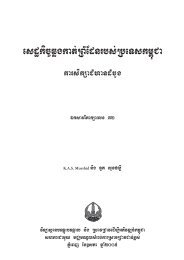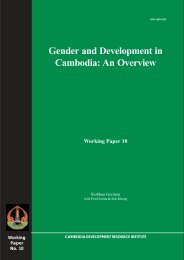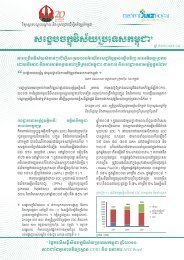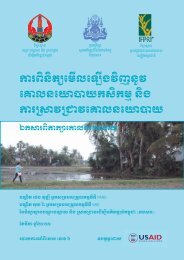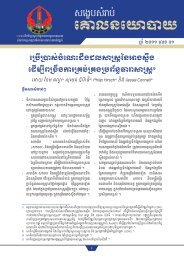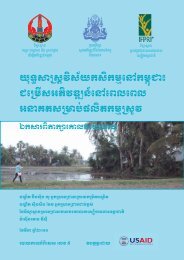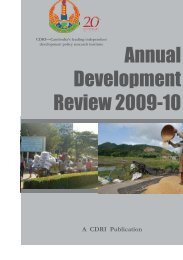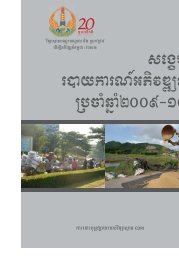62) decentralised governance of irrigation water in cambodia - CDRI
62) decentralised governance of irrigation water in cambodia - CDRI
62) decentralised governance of irrigation water in cambodia - CDRI
Create successful ePaper yourself
Turn your PDF publications into a flip-book with our unique Google optimized e-Paper software.
5.4 Stakeholder Coord<strong>in</strong>ation<br />
5.4.1 Local Coord<strong>in</strong>ation<br />
Coord<strong>in</strong>ation and <strong>in</strong>formation flow between all relevant stakeholders from local to<br />
national scale is critical to implement<strong>in</strong>g PIMD, yet field <strong>in</strong>terviews and observations revealed<br />
that this rema<strong>in</strong>s <strong>in</strong>consistent with<strong>in</strong> and between stakeholder groups across the three case<br />
study schemes. Furthermore, conflicts emanat<strong>in</strong>g from <strong>water</strong> scarcity, lack <strong>of</strong> camaraderie and<br />
<strong>in</strong>equitable <strong>water</strong> allocation, among other factors, commonly arise <strong>in</strong> each <strong>of</strong> the schemes.<br />
Theoretically at least, FWUCs are to delegate the management <strong>of</strong> small tertiary canals<br />
(between paddy fields) to FWUGs. Although FWUGs had been established (e.g. <strong>in</strong> Rolous),<br />
their significance was small and while there was some communication with<strong>in</strong> FWUGs,<br />
there was little to no communication between them. In Stung Ch<strong>in</strong>it, the FWUC committee<br />
organised separate meet<strong>in</strong>gs <strong>in</strong> each village with<strong>in</strong> the scheme to discuss <strong>water</strong> related issues<br />
with farmers. The Stung Ch<strong>in</strong>it FWUC leader stated that 30-50 people from each village are<br />
expected to attend the meet<strong>in</strong>gs, but these numbers were not always met. One Prasat villager<br />
stated that only 10-30 farmers from his village would attend which did not represent all <strong>of</strong> the<br />
farmers. Overall, it was stated that approximately 50-60 percent <strong>of</strong> the scheme’s total number<br />
<strong>of</strong> farmers had attended these meet<strong>in</strong>gs.<br />
Examples <strong>of</strong> self-organised farmer coord<strong>in</strong>ation were seen <strong>in</strong> Rolous, where small groups<br />
<strong>of</strong> farmers with adjacent fields had pooled their money to pay the fuel costs <strong>of</strong> <strong>irrigation</strong> pumps.<br />
This local coord<strong>in</strong>ation however was found to only occur <strong>in</strong> the rice fields near to the ma<strong>in</strong> canal<br />
<strong>in</strong> the west. Elsewhere <strong>in</strong> the scheme farmers faced similar co-ord<strong>in</strong>ation issues to farmers <strong>in</strong><br />
other schemes <strong>of</strong>ten related to the over use <strong>of</strong> fertilisers which affect downstream rice paddies,<br />
and the cutt<strong>in</strong>g <strong>of</strong> dykes and levees without consult<strong>in</strong>g neighbour<strong>in</strong>g farmers.<br />
Infrastructure development is vital to the effective and timely allocation <strong>of</strong> <strong>water</strong>;<br />
however, it requires a high level <strong>of</strong> commitment and participation from all stakeholders. Lack<br />
<strong>of</strong> cooperation and commitment from farmers <strong>of</strong> the farmers was <strong>of</strong>ten found to be a major<br />
barrier to <strong>in</strong>frastructure development <strong>in</strong> the case-study schemes. In DAP, farmer <strong>in</strong>terviews<br />
revealed that most farmers are will<strong>in</strong>g to allow new construction or restoration <strong>of</strong> the tertiary<br />
canals that were built <strong>in</strong> the mid 1970s; however, farmers with small rice paddies objected<br />
to any canals be<strong>in</strong>g built at all as the construction would require them to sacrifice a portion<br />
<strong>of</strong> their already <strong>in</strong>substantial land which would have a significant effect on their <strong>in</strong>come and<br />
livelihood.<br />
…I have only a very small paddy plot <strong>of</strong> about 30 m square. I live alone. I need to rent it<br />
to get some money to buy th<strong>in</strong>gs from the pagoda. If the canal is built, it will cut across<br />
the middle <strong>of</strong> my paddy land, I will lose land, so I would not agree to contribute my paddy<br />
land… (Kmar Villager, DAP Scheme, 2010)<br />
A general sentiment expressed by many <strong>of</strong> the farmers <strong>in</strong>terviewed from each case study<br />
scheme was that they would be will<strong>in</strong>g to contribute money and cooperate <strong>in</strong> projects that would<br />
br<strong>in</strong>g them quick and direct benefits and would not <strong>in</strong>cur further risks to their livelihoods.<br />
The Pursat PDOWRAM director po<strong>in</strong>ted out that the key criteria for successful<br />
management and allocation <strong>of</strong> <strong>water</strong> by the FWUC committees are technical capacity,<br />
coord<strong>in</strong>ation and good <strong>in</strong>formation flow/communication between PDOWRAM, FWUC and<br />
local farmers and villagers. More specifically it is necessary for FWUC committees to be<br />
26 Decentralised Governance <strong>of</strong> Irrigation Water <strong>in</strong> Cambodia: Match<strong>in</strong>g Pr<strong>in</strong>ciples to Local Realities



